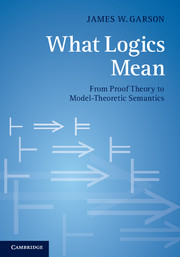Book contents
- Frontmatter
- Dedication
- Contents
- Preface
- Acknowledgements
- 1 Introduction to model-theoretic inferentialism
- 2 Deductive expression
- 3 Local expression
- 4 Global expression
- 5 Intuitionistic semantics
- 6 Conditionals
- 7 Disjunction
- 8 Negation
- 9 Supervaluations and natural semantics
- 10 Natural semantics for an open future
- 11 The expressive power of sequent calculi
- 12 Soundness and completeness for natural semantics
- 13 Connections with proof-theoretic semantics
- 14 Quantifiers
- 15 The natural semantics of vagueness (with Joshua D. K. Brown)
- 16 Modal logic
- Summary
- References
- Index
13 - Connections with proof-theoretic semantics
Published online by Cambridge University Press: 05 June 2014
- Frontmatter
- Dedication
- Contents
- Preface
- Acknowledgements
- 1 Introduction to model-theoretic inferentialism
- 2 Deductive expression
- 3 Local expression
- 4 Global expression
- 5 Intuitionistic semantics
- 6 Conditionals
- 7 Disjunction
- 8 Negation
- 9 Supervaluations and natural semantics
- 10 Natural semantics for an open future
- 11 The expressive power of sequent calculi
- 12 Soundness and completeness for natural semantics
- 13 Connections with proof-theoretic semantics
- 14 Quantifiers
- 15 The natural semantics of vagueness (with Joshua D. K. Brown)
- 16 Modal logic
- Summary
- References
- Index
Summary
In the introduction of this book, it was claimed that model-theoretic inferentialism and proof-theoretic inferentialism need not be enemies, and that results of this book can actually be of service to the proof-theoretic tradition. This chapter provides details to support that claim. The fundamental problem to be solved in the proof-theoretic paradigm is to find an answer to the problem of tonk. The rules for tonk show that not every collection of rules can define a connective, and so proof-theoretic conditions must be found that are independently motivated, and distinguish those rules that successfully define connective meaning from those that do not. Sections 13.1 through 13.3 discuss conservativity, one of the most widely discussed constraints of this kind. Here it is shown that natural semantics may be used to help motivate that condition. Section 13.4 discusses uniqueness. In Section 13.5, notions of harmony based on the inversion principle and normalization of proofs are briefly reviewed. In the following section, a model-theoretic notion called unity is introduced, and compared with harmony notions in the proof-theoretic tradition (Section 13.7). In the final section (13.8), it is shown that natural semantics can be revised in a near-trivial way to provide proof-theoretic accounts of logical consequence and harmony. Brief comparisons are drawn between proof-theoretic ideas in the literature and these new proposals.
Conservation and connective definition
Our investigation into the prospects for model-theoretic inferentialism has been inspired by the idea that natural deduction rules provide a syntactic method for defining the meanings of the connectives. However, not every set of ND rules will do. Prior (1960) showed that there is a pair of introduction and elimination rules for a connective c that determines no coherent interpretation of c. (See also Wagner (1981) and Hart (1982).) For example, if we try to define the connective tonk by the rules A ⊢ A tonk B and A tonk B ⊢ B, we have the unwelcome result that A ⊢ B holds for any choice of A and B. The tonk rules don’t fix a meaning for tonk; they disastrously alter the nature of deduction in the system.
Information
- Type
- Chapter
- Information
- What Logics MeanFrom Proof Theory to Model-Theoretic Semantics, pp. 187 - 210Publisher: Cambridge University PressPrint publication year: 2013
